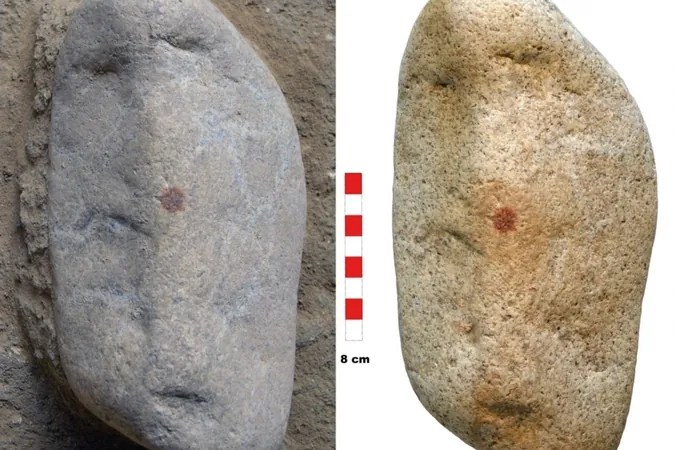
Did a Neanderthal Create a 'Face' in Stone 43,000 Years Ago?
2025-05-31
Author: Michael
A Surprising Discovery in a Spanish Cave
In a remarkable archaeological find, researchers digging in a cave in Segovia, Spain, stumbled upon a rock that strikingly resembles an elongated face. This hand-sized stone features a red pigment—made from ochre—right at what could be seen as the tip of its nose.
A Research Team's Fascinating Theory
David Álvarez Alonso, an archaeologist from Complutense University in Madrid, expressed that the entire team felt an instinctive recognition of the rock's face-like shape. Over the next three years, they rigorously examined this unusual artifact, positing that it might bear witness to one of the earliest symbolic behaviors by Neanderthals—specifically, that 43,000 years ago, a Neanderthal artist marked the stone with a finger dipped in ochre.
Implications of the Findings
Published in the journal *Archaeological and Anthropological Sciences*, the team's findings suggest that the strategic placement of the red dot indicates not just a random shape, but rather a meaningful intervention that could represent one of humanity's first attempts at art.
The researchers noted, "This indicates a human mind capable of symbolizing and projecting thoughts onto an object," highlighting the cognitive capabilities of Neanderthals.
Artistic Expression: A Controversial Debate
The notion that Neanderthals were capable of creating art remains a hotly debated topic. However, findings over the last decade hint that the roots of artistic expression run deeper in human evolution than previously believed. This new study adds weight to that argument.
Investigating the Evidence
In order to bolster their theory, researchers created a 3D model of the rock and analyzed the measurements between its features. The dot—or 'nose'—was precisely positioned, reinforcing the argument that it was intentionally marked. Geologists substantiated that the red dot indeed came from ochre, and forensic specialists confirmed the presence of a distinctive fingerprint, potentially that of a Neanderthal.
Skepticism from Experts
However, not everyone is convinced. Gilliane Monnier, an anthropology professor from the University of Minnesota, expressed reservations, questioning if Neanderthals actually perceived the rock as a face. She suggested that natural geological processes may have created the depressions and the coloring, challenging the researchers’ conclusions.
Future Research Needed
While the researchers admit that their theory may not resolve all doubts, they argue that it provides a plausible explanation for this ancient artifact. This face-shaped rock certainly adds an intriguing dimension to the study of early human cognitive abilities, but further research is essential to clarify its role in our understanding of art's evolution.









 Brasil (PT)
Brasil (PT)
 Canada (EN)
Canada (EN)
 Chile (ES)
Chile (ES)
 Česko (CS)
Česko (CS)
 대한민국 (KO)
대한민국 (KO)
 España (ES)
España (ES)
 France (FR)
France (FR)
 Hong Kong (EN)
Hong Kong (EN)
 Italia (IT)
Italia (IT)
 日本 (JA)
日本 (JA)
 Magyarország (HU)
Magyarország (HU)
 Norge (NO)
Norge (NO)
 Polska (PL)
Polska (PL)
 Schweiz (DE)
Schweiz (DE)
 Singapore (EN)
Singapore (EN)
 Sverige (SV)
Sverige (SV)
 Suomi (FI)
Suomi (FI)
 Türkiye (TR)
Türkiye (TR)
 الإمارات العربية المتحدة (AR)
الإمارات العربية المتحدة (AR)